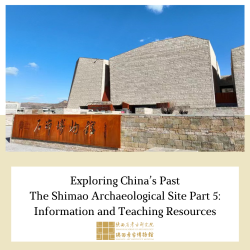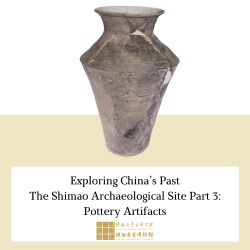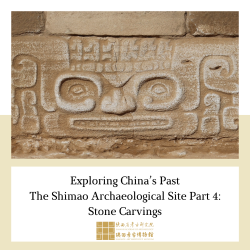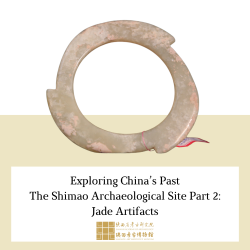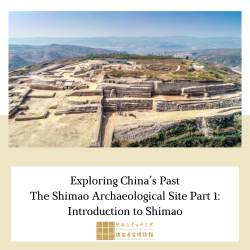Shaanxi Academy of Archaeology's collections
Exploring China’s Past: The Shimao Archaeological Site Part 5: Information and Teaching Resources
<p>This resource contains information and teaching resources about the Shimao archaeological site, an ancient stone-built fortress city close to the Ordos Desert in China’s Shaanxi Province that is believed to have flourished in the late Neolithic (ca. 5000-2000 B.C.E.) to the early Xia Dynasty (ca. 2100-1800 B.C.E.). Shimao's early date and location in the hills of China's Loess Plateau in the northern part of Shaanxi Province surprised many upon its discovery and it has changed our understanding of early Chinese civilization. People living near the site originally believed the crumbling rock walls they saw were originally part of the Great Wall. However, systematic archeological survey and reexamination of the site since about 2011 has revealed many exciting discoveries. Researchers working there, including Zhouyong Sun of the Shaanxi Provincial Institute of Archaeology who is leader of the dig, stated “Shimao reveals a unique trajectory to urbanism in China. This once-powerful kingdom was completely unknown in ancient textual records” (<a href="https://archaeology.org/issues/january-february-2021/collection/china-shimao-neolithic-city/">https://archaeology.org/issues...</a>).</p>
<p> We now know that the Shimao city site was a very large center of settlement, the main part of which encompasses an almost 1,000-acre area (more than 4 million square meters and 25% bigger than New York City's Central Park). Carbon dating at the site reveals that constructions in the city's core areas date back to approximately 4,300 to 3,800 years ago. Yet, only a part of Shimao has been excavated so far so there will likely be be more discoveries that will lead to our understanding of this early "palace city."</p>
<p>The five resources together form a collection that can be used independently or together to discover more about this amazing archeological site. We hope that this will provide authoritative information to enable you to examine background information about the site along with various objects used to illuminate aspects of early Chinese history, artistic traditions, culture and society. <br><br></p>
 Shaanxi Academy of Archaeology
Shaanxi Academy of Archaeology
10
Exploring China’s Past: The Shimao Archeological Site Part 3: Pottery Artifacts
<p>In this activity, students will use visual evidence to make inferences about the parts, shapes, and purposes of pottery objects found in Shimao, an ancient fortress city in China’s Shaanxi Province that is believed to have flourished in the late Neolithic to the early Xia Dynasty (2300 - 1800 B.C.E.). Continuous work by archeologists, researchers who study human history through artifacts and other material remains, began on this site in 2011. More than 40,000 objects of various materials have since been discovered.</p>
<p>During the late Neolithic period, a number of cultures lived in settlements across today’s mainland China. Each culture was different, but had shared similarities such as the creation of objects. Although pottery is the most common type of object found at Neolithic sites, objects unearthed at Shimao are made of pottery, jade, and bone and also include stone carvings and painted wall frescoes. </p>
<p>The objects were found in several different locations throughout the almost 1,000-acre area (more than 4 million square meters) site of Shimao. They are some of the best archaeological evidence researchers have for understanding the spiritual beliefs, artistic, and other values/purposes of this early civilization from around 4,000 years ago.</p>
<p>Through guided observation, students will discover more about the many pottery shapes and types of wares found at the Shimao archeological site. Students will discover some of the answers to these and other questions to learn about the origins of Chinese civilization.</p>
<p><br></p>
 Shaanxi Academy of Archaeology
Shaanxi Academy of Archaeology
13
Exploring China’s Past: The Shimao Archeological Site Part 4: Stone Carvings
<p>In this activity, students will explore various stone carvings found in Shimao, an ancient fortress city in China’s Shaanxi Province that is believed to have flourished in the late Neolithic to the early Xia Dynasty (2300 - 1800 B.C.E.). </p>
<p>The Shimao site consists of three parts: a fortress or ‘Citadel’ known in Chinese as the <em>Huangchengtai</em> (pronunciation: <em>huángchéngtái)</em> which is protected by an inner city bounded by masonry walls, and an outer city also bounded by masonry walls. Together these parts encompass an almost 1,000-acre area (more than 4 million square meters). </p>
<p>Excavation work at the ‘Citadel’ at the heart of the site revealed a high platform base with a stone retaining wall. Several stone carvings with various decorative patterns, including those of human figures, were initially unearthed by archaeologists, researchers who study human history through artifacts and other material remains, from the south retaining wall and passageway of the 'Citadel.' Ongoing, systematic excavations since 2011 have also revealed stone carvings of various types in other areas of the site.</p>
<p>As the largest and most important city site in East Asia from this period that has been discovered to date, the Shimao site provides some of the best archaeological evidence researchers have for understanding the spiritual beliefs, artistic insights and production methods, and other values/purposes of this early civilization from around 4,000 years ago.</p>
<p>Through guided observation, students will discover more about the different types of stone carvings and what the images may depict. They will also learn why they were made to increase their knowledge about the origins of Chinese civilization.</p>
 Shaanxi Academy of Archaeology
Shaanxi Academy of Archaeology
13

